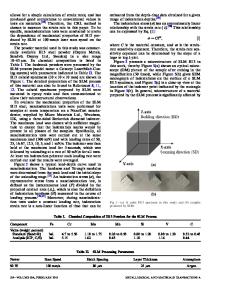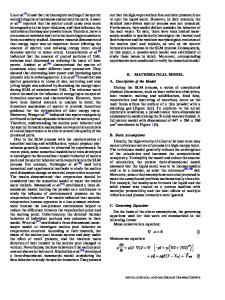Investigation of creep behavior of 316L stainless steel produced by selective laser melting with various processing para
- PDF / 4,902,168 Bytes
- 11 Pages / 595.22 x 842 pts (A4) Page_size
- 21 Downloads / 284 Views
DOI 10.1007/s12206-020-0717-z
Journal of Mechanical Science and Technology 34 (8) 2020 Original Article DOI 10.1007/s12206-020-0717-z Keywords: · Additive manufacturing (AM) · Cellular dendrite · Creep deformation · Defect · Laser power · Melt pool boundary · Pore · Scanning speed · SS316L
Correspondence to: Kee Bong Yoon [email protected]
Citation: Yu, J. M., Dao, V. H., Yoon, K. B. (2020). Investigation of creep behavior of 316L stainless steel produced by selective laser melting with various processing parameters. Journal of Mechanical Science and Technology 34 (8) (2020) ?~?. http://doi.org/10.1007/s12206-020-0717-z
Received March 4th, 2020 Revised
April 26th, 2020
Accepted May 29th, 2020 † Recommended by Editor Chongdu Cho
Investigation of creep behavior of 316L stainless steel produced by selective laser melting with various processing parameters Jong Min Yu, Van Hung Dao and Kee Bong Yoon Department of Mechanical Engineering, Chung-Ang University, 84 Heukseok-ro, Dongjak-gu, Seoul 06974, Korea
Abstract
Creep behavior of 316L stainless steel was experimentally investigated using small punch (SP) specimens produced by the selective laser melting (SLM) with various processing parameters. Five rectangular blocks were fabricated from gas atomized powder using the SLM. Various combinations of the processing parameters were used in the SLM process, such as the scanning speed and the laser power, when the energy density was kept as a constant. The scanning speed was increased from 336 to 784 mm/s, while the laser power was simultaneously increased from 165 to 385 W. The microstructural characteristics of each block were examined to verify the manufacturing conditions. Internal defects such as pores and unmelted powder were observed in the specimens fabricated when the low laser power was used. Small punch (SP) creep tests were carried out at 650 oC in the applied load range of 320550 N. Creep-rupture life and Norton’s power law creep deformation constants were measured. The results showed that even though the energy density condition was same for all of the creep specimens, those with higher laser power showed better creep resistance. Since it was known that a higher scanning speed could deteriorate the creep resistance, the higher creep resistance under the high scanning speed condition was indebted to the higher laser power used. The observed creep behavior of the SLM blocks was explained in relation to the microstructures.
1. Introduction
© The Korean Society of Mechanical Engineers and Springer-Verlag GmbH Germany, part of Springer Nature 2020
Additive manufacturing (AM) is a technique for building three-dimensional products that have complex geometries by successively adding material layers using the powder material. The AM has a conceptually different approach from the conventional manufacturing method, in which the material is constantly removed to make a component shape. By the AM, the product shape can be made with little material waste, while the conventional manufacturing method generates more
Data Loading...











